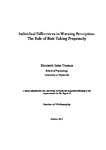Individual differences in warning perception: The role of risk taking propensity.
| dc.contributor.supervisor | Hellier, E | |
| dc.contributor.supervisor | Edworthy, J | |
| dc.contributor.supervisor | Handley, S | |
| dc.contributor.author | Gabe-Thomas, Elizabeth | |
| dc.contributor.editor | Hellier E | |
| dc.contributor.editor | Edworthy J | |
| dc.contributor.editor | Handley S | |
| dc.date.accessioned | 2016-10-03T09:47:02Z | |
| dc.date.available | 2016-10-03T09:47:02Z | |
| dc.date.issued | 2012-09-23 | |
| dc.date.submitted | 2012-04-01 | |
| dc.identifier.uri | http://hdl.handle.net/10026.1/5543 | |
| dc.description.abstract |
Warnings are intended to improve safety (decreasing injury, illness and loss) by communicating the presence and nature of a potential hazard and encouraging behaviour that will minimise or avoid a negative outcome. Warnings can be seen as representations of risk, therefore it is likely that an individual’s attitude towards risk, their risk-taking propensity, may impact upon the way they perceive warnings. Establishing this relationship may have important practical implications. If high risk-taking propensity can predict non-compliance, then attempts may be made to increase compliance within high risk-takers by tailoring warnings to such individuals. This thesis aims to explore empirically the relationship between measures of risk-taking propensity and warnings, with potential application to the prevention of hazardous behaviours. Study One investigated the potential relationship between risk-taking propensity and warning perception using an exploratory approach. The results confirmed an effect of various measures of risk-taking propensity on warning perceptions, in particular on intentions to comply with the warnings. Studies Two and Three revealed the domain specific nature of the relationship between risk-taking and warning perception and that it is stronger when contextual information about a hazard is provided. Study Four explored potential underlying mechanisms and revealed that anticipated regret mediated this relationship. Also simulation of positive outcomes of non-compliance was found to be influential. Study Five attempted to minimise the discrepancy between high and low risk-takers through warning design manipulation. This thesis offers a unique contribution to the literature, by establishing empirically the effect of risk propensity has on warnings perception, and by providing insight into the theoretical underpinnings of this relationship. | |
| dc.language.iso | en | |
| dc.subject | Risk Taking | |
| dc.subject | Warnings | |
| dc.title | Individual differences in warning perception: The role of risk taking propensity. | |
| dc.type | thesis-dissertation | |
| plymouth.publisher-url | https://pearl.plymouth.ac.uk//handle/10026.1/1004 | |
| plymouth.organisational-group | /Plymouth | |
| plymouth.organisational-group | /Plymouth/Faculty of Health | |
| plymouth.organisational-group | /Plymouth/Faculty of Health/School of Psychology | |
| plymouth.organisational-group | /Plymouth/REF 2021 Researchers by UoA | |
| plymouth.organisational-group | /Plymouth/REF 2021 Researchers by UoA/UoA04 Psychology, Psychiatry and Neuroscience | |
| plymouth.organisational-group | /Plymouth/Research Groups | |
| plymouth.organisational-group | /Plymouth/Research Groups/Centre for Brain, Cognition and Behaviour (CBCB) | |
| plymouth.organisational-group | /Plymouth/Research Groups/Centre for Brain, Cognition and Behaviour (CBCB)/Behaviour | |
| plymouth.organisational-group | /Plymouth/Users by role | |
| rioxxterms.licenseref.uri | http://www.rioxx.net/licenses/all-rights-reserved | |
| rioxxterms.type | Thesis |


